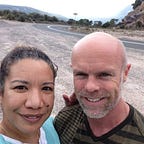The Biophysics of Ecstatic Dance
By Bill Softky
Sunday, for the umpteenth time, I undulated and stomped to live music across a sunlit dance floor among my spinning fellow creatures, no one talking, all of us moving happily one way or another, a few pair-dancing, a few hugging, a few caressing. As I danced, my arms still waving their delights, a flood of tears — of gratitude, I hope — flowed down my face at seeing how we humans love each other’s company when we get half a chance.
It’s a wonderful, joyous feeling to be part of a community which exists entirely to enjoy each other in sacred space. We wanted to be there, and those emotions were as genuine as any I’ve ever felt. But the emotions and the tears could have a more mundane explanation: although my neck had been sore that morning, the Dance had relaxed and released my cervical vertebrae, which now glided with supple smoothness. Then, the neck-relaxation propagated a tiny distance (in brain-space) to the tear-gland circuits, which then let flow. So I don’t know if the flexibility of my neck caused my emotions and my tears, or the other way around (and I’m a biophysicist). All I know is both are good for me and for my friends. Afterwards, many of us sit in circle to share stories in confidence, often of how the Dance has healed us from self-defeat, abuse or even cancer. The healing makes scientific sense.
It also makes scientific sense that our evolutionary heritage rewarded this kind of intimate trust, far more than rewarding hostility or greediness. Our ancestors lived in kin-groups on the savannah, everyone essential to survival, and all that close coooperation could have made us the most loving species ever lived. So my fellow dancers’ happiness in “Ecstatic Dance” was likely part of Nature’s plan to bond us close, and our practice of communal autonomous motion is as close to “paleo socializing” as modern society allows.
The match between what the Dance provides and what our sensorimotor systems need is almost perfect. Bare feet, check. Full-spectrum flicker-free light, check. Full freedom of motion, check. Positive collective intention, check. Judgement-free environment, check. Close-proximity 3-D multi-sensory interaction, check. All this in the glitch-free, infinite-resolution, zero-latency communications medium we call “real life,” insulated from commerce and doctrine, even from words. In tech-geek terms, our Dance is the highest-bandwidth, lowest-interference interaction humans could hope for short of sex, and this according to the very metrics gamers pay big bucks for. In other words, Dance maximizes our biological channel capacity,
Once you realize that nervous systems which consume information must obey the same equations as technologies which consume information, it’s easy to make a checklist of “sensorimotor needs” and see how well they’re fed by various activities, from community activities like Ecstatic Dance and church at the top, to TV and texting at the bottom. The checklist looks like this:
The reasoning behind these conclusions is obvious in hindsight to anyone with a technical degree, but it is very little known. The gist is two-fold. First, that as vertebrates and primates we trust in sensorimotor communications channels carrying the vibratory coherence-signatures of other vibrating, walking beings like ourselves. Micro-expressions, nano-gestures, contagious moods, and felt “energy” are merely facets of this native broadband vibratory protocol. These channels carry far more bandwidth than words, and yet due to their very speed cannot be tracked consciously. These are what we use to trust our senses and ourselves.
Second, that the very tricks which allow our nervous systems to see and feel the world must also, by their very nature, make us prey to digital distractions. Our attention circuitry evolved to track a neutral and diverse Nature, not to be distracted by technologies like Angry Birds evolved to do exactly that. Put these two separate facts together, and modern humans face a situation where we spend so much time on screens we never get the vibratory trust our nervous systems need.
So thank God for the Ecstatic Dance “container,” the rules and temporary space held sacred by the community and the DJ who sculpts our collective sonic experience. The DJ, by plucking the chords of our nervous systems and resonating us with one another, entrains us with the music and each other in the most intimate, subtle ways possible. That resonance is the organic reference signal our nervous systems need, the human carrier-wave.
My adult daughter aspires to be a DJ (as a calling, not a job). I wish her well, since helping people move as one is sacred in the toughest scientific sense there is.
